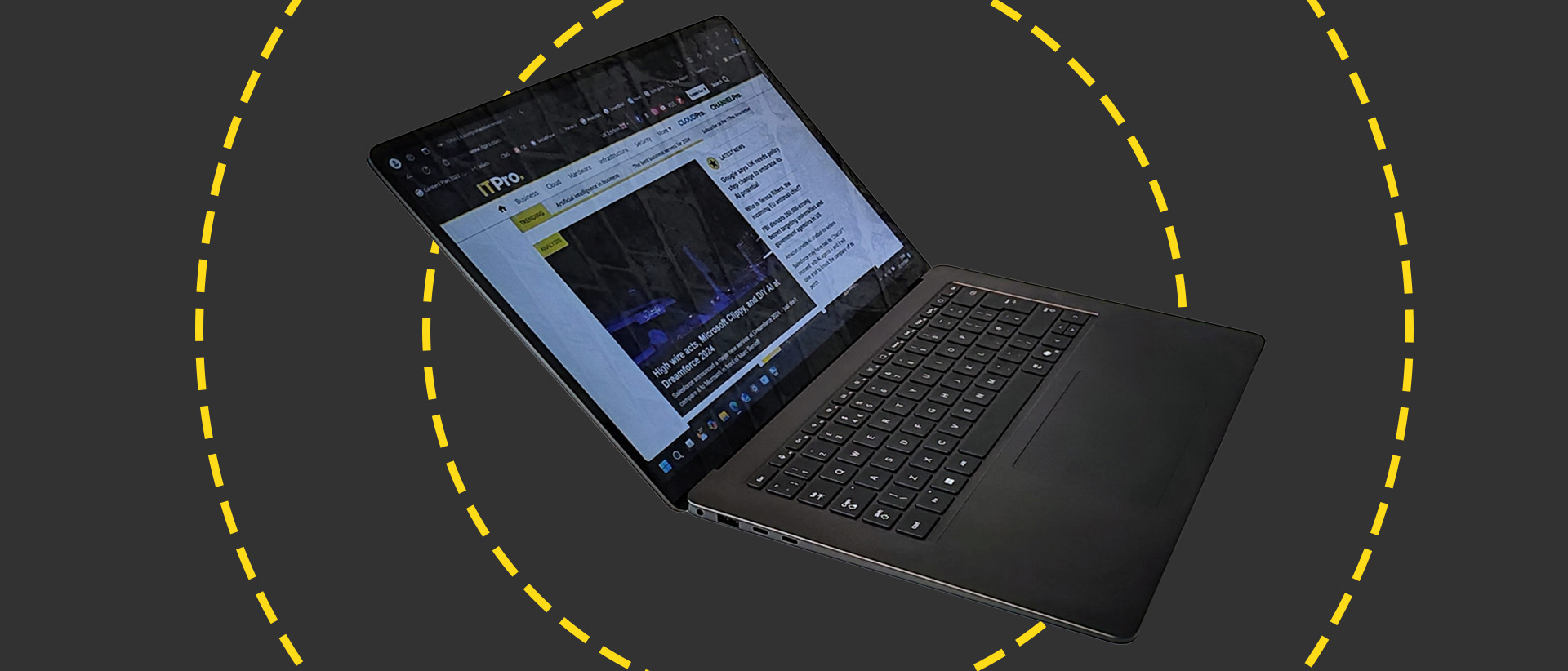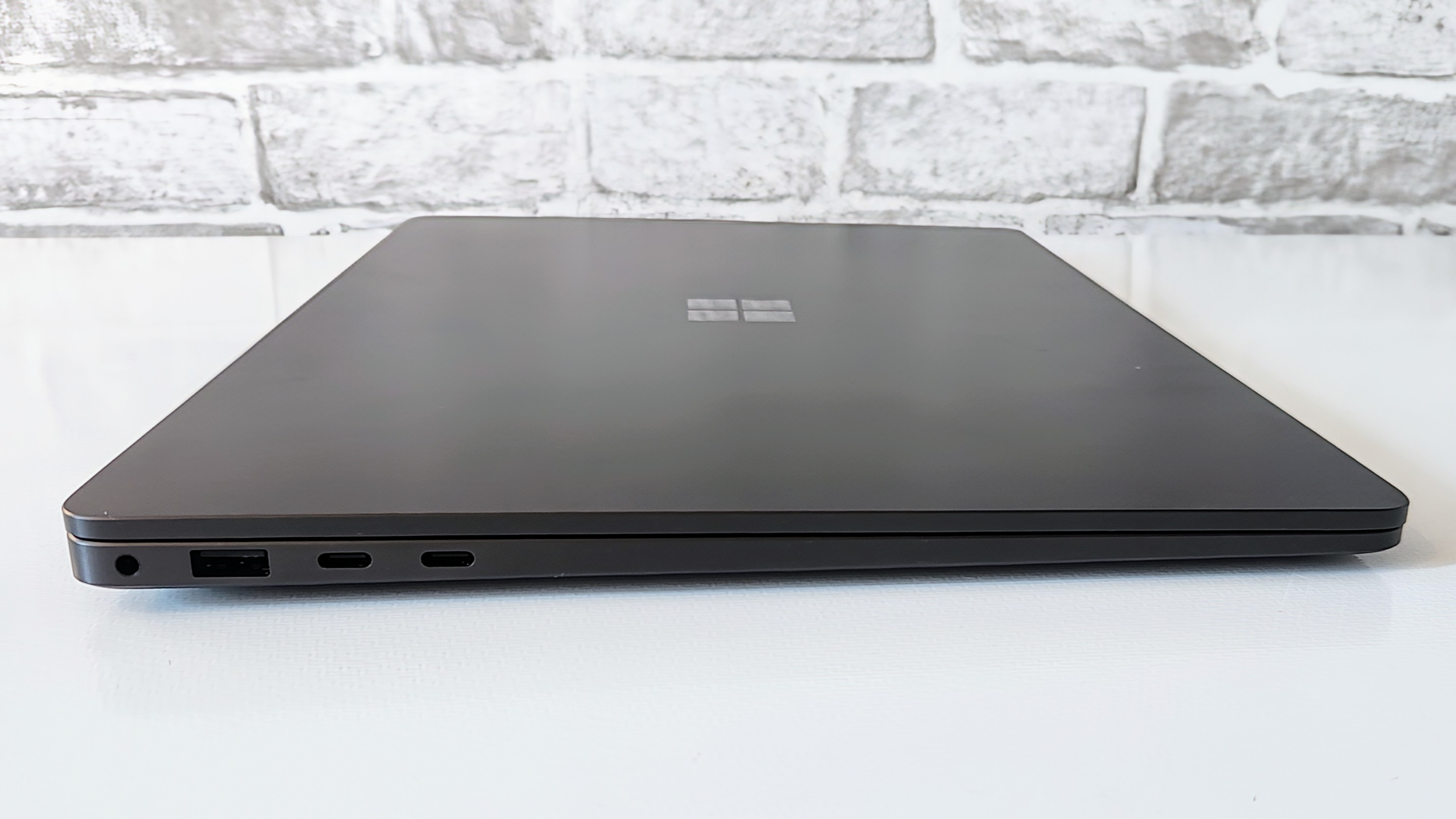Microsoft Surface Laptop 7 review: The definitive Snapdragon business laptop
With its bright 3:2 display, easy-access interior, and superb battery life, the Surface Laptop 7 is a stellar productivity tool

-
+
Stunning battery life
-
+
Premium design and build
-
+
Easy access to the internals
-
+
Good range of ports
-
-
Limited post-purchase upgrade options
-
-
Larger SSDs are exorbitantly priced
-
-
Surface Dock is an expensive accessory

Given that Microsoft is the prime mover of Windows-on-ARM development you'd expect its own-brand Surface machines to be the definitive statement on the subject, even in the face of such compelling competition as Lenovo's Yoga Slim 7x and ThinkPad T14s Gen 6.
So far Microsoft has launched two machines running on Qualcomm's new Snapdragon chipset, the Surface Pro 7 tablet and the Surface Laptop 7, which carry the new Copilot Plus AI branding.
The first review unit that Microsoft has supplied us with is the top-spec 15in Surface Laptop 7 which comes with 32GB of RAM, a 1TB SSD, and costs £2,149 (£1,790 ex-VAT). However, unlike the Snapdragon-powered alternatives the Surface Laptop 7 comes in a plethora of models both smaller and cheaper.
Starting with the 15in version, the 16GB model with a 256GB SSD costs just £1,349 (£1,125 ex-VAT). For £200 extra you can have a 512GB SSD or for £400 more a 1TB SSD. Presumably, Microsoft has looked at what Apple is charging for extra storage in the MacBook Air and decided it can get away with the same excessive markup.
The 13.8in Surface Laptop 7 is as you'd expect cheaper. The starting price is £1,049 (£875 ex-VAT), though for that you must make do with the less powerful 10-core Snapdragon X Plus processor with 16GB of RAM and a 256GB SSD. The X Elite version starts at £1,449 (£1,207 ex-VAT) for 16GB RAM and a 512GB SSD and soars to £2,049 (£1707 ex-VAT) for the model with 32GB RAM and 1TB SSD.
The fashion-conscious can choose between four colorways; Black, Platinum Dune, and Saphire though oddly the 15in model is only available in the first two. Currently, the 32GB versions of the 13.8 and 15in models are exclusive to the Microsoft Store.
Microsoft Surface Laptop 7: Design

The larger Surface Laptop 7 is a handsome beast and continues the clean, minimalist industrial design philosophy that's been a hallmark of Microsoft's Surface Laptop design language since day one. However, the Alcantara deck now sadly seems to be a thing of the past.
The chassis and lid – which only angles back to 45 degrees – are made from recycled aluminium which makes for a very solid bit of kit. The matte paint finish isn't entirely resistant to greasy fingerprints but I've seen much worse.
At 1.45Kg the Surface 7 Laptop is lighter than the 15in MacBook Air which weighs 1.5Kg. Oddly Microsoft credits the 15in Laptop Surface 7 with a weight of 1.66kg but my calibrated scales beg to differ. At 329 x 239 x 18.9 the Surface 7 is shorter but fatter than the MacBook Air but the differences are verging on the negligible.
RELATED WHITEPAPER

On the left side of the Surface 7, you'll find two USB-C 4/Thunderbolt 4 ports both of which support 65W PD charging, DP Alt Mode video output and 40Gbits/sec data transfer, a 5Gbits/sec USB-A port and a 3.5mm audio jack. On the right, there's a microSDXC card slot and one of Microsoft's magnetic Surface Connect ports so you can charge the laptop without having to use one of the USB-C ports and connect Microsoft's excellent – but expensive – Surface Dock 2. As you'd expect wireless communications are bang up to date with the Qualcomm wireless card supporting Wi-Fi 7 and Bluetooth 5.4.
Getting inside the Surface 7 could hardly be easier. Just prise off the four rubber feet, undo the single Torx T5 screw beneath each one, and remove the magnetically attached base plate. Once inside you'll find that the only item you can upgrade is the 2230 M.2 SSD as the memory modules are soldered in place.
Repairability on the other hand is exceptional. A QR code on the battery directs you to Microsoft's service documentation while all the important components are labeled to tell you how many screws and of what type you need to undo to remove it. If you or your IT support need to replace an item like the battery, fan or one of the data ports they are easy to swap out.
Microsoft Surface Laptop 7: Keyboard, touchpad and webcam
The first thing you notice about the keyboard is how solid it is, there's very little give even when you push down hard on the G/H/J keys. The typing action is perfect with each key moving smoothly along its 1.5mm of travel to a firm end stop. The keycap graphics are models of clarity and the three-stage white backlight works perfectly.
Thanks to the absence of a numeric keypad the keyboard and touchpad are both centrally placed which is always a welcome design feature.
The haptic touchpad isn't the largest example of the breed at just 120 x 80mm despite there being quite a bit of free space all around it. It is however a joy to use, superbly reactive, and virtually silent. It's one of, if not the, best haptic touchpads we've used on a Windows machine and gives very little away to Apple's best. If for some reason the haptic settings are not to your liking out of the box you can adjust all the important parameters in the Touchpad settings menu.

As far as webcams go the 1080p unit fitted to the Surface 7 is decent enough though with the the likes of Acer and Asus now fitting 1440p cameras there is nothing to get overly excited about. Images were crisp and colorful even in less-than-ideal lighting and of course, the full suite of Microsoft's Studio Effects AI enhancements are available.
The camera also supports Windows Hello facial authentication but we did rather bemoan the lack of a fingerprint scanner, privacy shutter, or anything in the way of presence detection.
Microsoft Surface Laptop 7: Display
Rather than an OLED screen as used by Asus in its Yoga Slim 7x Microsoft has opted for an IPS panel, and a fine one it is too, complete with a 10-point touch interface and high-gloss finish.
Peak brightness registered at an impressive 589cd/m2 and there was color aplenty too with gamut volumes of 136.6% sRGB, 94.1% Adobe RGB, and 96.8 DCI-P3. The display has two color profiles built-in; sRGB which gives a Delta E accuracy of 1.15 and Vivid which corresponds to the DCI-P3 color space and gives an equally impressive Delta E of 1.14.
In an ideal world, we like to see Delta E figures below 1 as we did in Yoga Slim 7x but the Surface 7's scores are so close it seems niggardly to mark it down on this front.
Combine those colorimeter results with a super-sharp 2,496 x 1,664 matrix that gives a 201PPI pixel density, 3:2 aspect ratio, and a dynamic refresh rate that can hop between 60 and 120Hz and you have a near-perfect display for most productivity requirements.
Putting the Windows into HDR mode doesn't do anything for the peak brightness level but given the SDR figure and the contrast ratio of 1955:1 the screen does a good job of rendering HDR content.
Microsoft Surface Laptop 7: Specs and Performance
The Snapdragon X Elite XE1-80-100 chipset in the 15in Surface 7 is slightly more powerful than the X1E-78-100 inside the Lenovo Yoga Slim 7x thanks to the processor having a 4GHz boost feature on two of its cores. The difference in performance between the two chips can't be noticed in the real world and is barely in evidence under test conditions with the Geekbench 6 multicore test scoring 14,520 on the Surface machine to 14,222 on the Yoga.
Both the XE1-80-100 and XE1-78-100 use the same Adreno GPU so we were expecting similar results and so it proved, with the Surface 7 delivering a slightly higher score in the 3DMark ARM-native Night Raid test of 26,922 to the Yoga Slim 7x's 25,988. As with the CPU test, the differences between the two Snapdragon machine's graphics performance won't be distinguishable in the real world.
In a broader context, the Surface 7 delivers the same sort of performance that we'd expect from an Intel Core Ultra 155H / Intel Arc or an Apple M3 SoC though the latter can deliver better graphics performance. The exact level of advantage the Mac has won't become fully clear until more native ARM tests – and games – appear for the Snapdragon platform.

We've said all we needed to say about app compatibility in our review of the Yoga Slim 7x. Thanks to the number of ARM-native apps around – Microsoft Office, Adobe Photoshop and Lightroom, DaVinci Resolve, GIMP, Blender, Chrome, Firefox, Spotify, and Netflix to name but ten popular apps and the performance of Microsoft's Prism emulation layer app support won't be an issue for the majority of users.
The one major app that does not run on ARM machines period is Google's Drive for Desktop but Google has recently announced that "Drive for Desktop support is coming to Windows ARM64 devices. Stay tuned for more updates on timing and availability."
The Samsung-made 1TB SSD in our review machine was a mediocre performer returning average sequential read and write speeds of 2,800MB/s and 2,130MB/s respectively. Lenovo's Yoga Slim 7x and ThinkPad T14s Gen 6 both performed significantly better in the read speed test. The SSD speed won't hamper the Surface 7's everyday performance but it's still a little disappointing.
Where the Surface Laptop 7 plays its trump card is with battery life. Looping a standard definition video in the x64 version of VLC the lights stayed on for a jaw-dropping 18 hours and 35 minutes. That's a stellar performance by Mac standards and other-worldly by x64 Windows standards, especially when you consider the battery capacity is only 55Wh.
Granted the ThinkPad T14s Gen 6 did even better but we expected that given that it uses a basic 1,920 x 1,200, 60Hz refresh rate display and runs on the less powerful Snapdragon X Elite X1E-78-100 chipset.
Naturally, the Surface 7 carries Microsoft's "Copilot+ PC" stamp of approval which means it has an NPU (neural processing unit) with at least 40 TOPS (trillions of operations per second) of local AI processing power.
At the moment that basically means support for Cocreator which is an AI image creation feature in Microsoft Paint, live captioning of videos (into English only), enhanced webcam effects, and, at some point in the near future, when Microsoft has either allayed privacy fears or feels comfortable enough to ignore them, Recall, which takes screenshots of your activity every few seconds and then lets you search them when you have a "Now where did I see that?" moment.
Microsoft Surface Laptop 7: Is it worth it?
For the business user, we'd argue that the new Surface Laptop 7 is the best of breed from the current crop of Snapdragon ARM laptops. The range of models is far wider than what's on offer from the competition while the 3:2, 2.5K display is ideal for the business user.
We also like the design, build quality, ease of access to the internals, and excellent battery life which even if bettered by the Lenovo T14s Gen 6 is still extraordinarily good for a Windows laptop. The support for Microsoft's excellent Surface Dock is also a feature not to be undervalued. The author never leaves home without it.
The Surface Laptop 7 is a little on the pricey side at the top of the range, but £1,549 (£1,290 ex-VAT) for the 15in, 16GB RAM, 512GB SSD model seems like good value from where we are sitting. Highly recommended.
Microsoft Surface Laptop 7 specifications
| Display | 15-inch 2.5K (2496 x 1664), 120 Hz IPS | Row 0 - Cell 2 |
| Processor | Qualcomm Snapdragon X Elite X1E-84-100 | Row 1 - Cell 2 |
| GPU | Snapdragon X Elite Qualcomm Adreno | Row 2 - Cell 2 |
| RAM | 32GB LPDDR5X | Row 3 - Cell 2 |
| Ports | 2x USB Type-C, 1x USB-A ports, 1 x Surface Connect | Row 4 - Cell 2 |
| Card reader | MicroSDXC | Row 5 - Cell 2 |
| Storage | 1TB PCIe 4 SSD | Row 6 - Cell 2 |
| Weight | 1.45kg (3.2lbs) | Row 7 - Cell 2 |
| Dimensions | 13 x 9.4 x 0.72 inches; 329 x 239 x 18.3mm (WxDxH) | Row 8 - Cell 2 |
| Operating System | Windows 11 Home | Row 9 - Cell 2 |
Get the ITPro daily newsletter
Sign up today and you will receive a free copy of our Future Focus 2025 report - the leading guidance on AI, cybersecurity and other IT challenges as per 700+ senior executives
Over the years, Alun has written freelance for several online publications on subjects ranging from mobile phones to digital audio equipment and PCs and from electric cars to industrial heritage. Before becoming a technology writer, he worked at Sony Music for 15 years. Quite what either occupation has to do with the degree in Early Medieval History he read at the University of Leeds is a bit of a grey area. A native of Scotland but an adopted Mancunian, Alun divides his time between writing, listening to live music, dreaming of the glens and dealing with an unhinged Norwegian Elkhound. For ITPro, Alun reviews laptops and PCs from brands such as Acer, Asus, Lenovo, Dell and HP.
-
 ‘Phishing kits are a force multiplier': Cheap cyber crime kits can be bought on the dark web for less than $25 – and experts warn it’s lowering the barrier of entry for amateur hackers
‘Phishing kits are a force multiplier': Cheap cyber crime kits can be bought on the dark web for less than $25 – and experts warn it’s lowering the barrier of entry for amateur hackersNews Research from NordVPN shows phishing kits are now widely available on the dark web and via messaging apps like Telegram, and are often selling for less than $25.
By Emma Woollacott Published
-
 Redis unveils new tools for developers working on AI applications
Redis unveils new tools for developers working on AI applicationsNews Redis has announced new tools aimed at making it easier for AI developers to build applications and optimize large language model (LLM) outputs.
By Ross Kelly Published
-
 Google layoffs continue with "hundreds" cut from Chrome, Android, and Pixel teams
Google layoffs continue with "hundreds" cut from Chrome, Android, and Pixel teamsNews The tech giant's efficiency drive enters a third year with devices teams the latest target
By Bobby Hellard Published